Western Hognose Snakes are small venomous snakes that have a fun personality!
Hognose snakes are known for their acting skills. They can play dead, flatten their neck ribs to “hood up” like a cobra and false strike.
One of the most interesting facts about this snake is that they are venomous.
Western Hognoses have rear fangs that produce a mild venom in their saliva to help them hunt. They also have a scoop nose for burrowing.
Their small size and gentle attitude make them a wonderful pet snake for beginners!
If you are looking to learn more about this small venomous snake then keep reading…
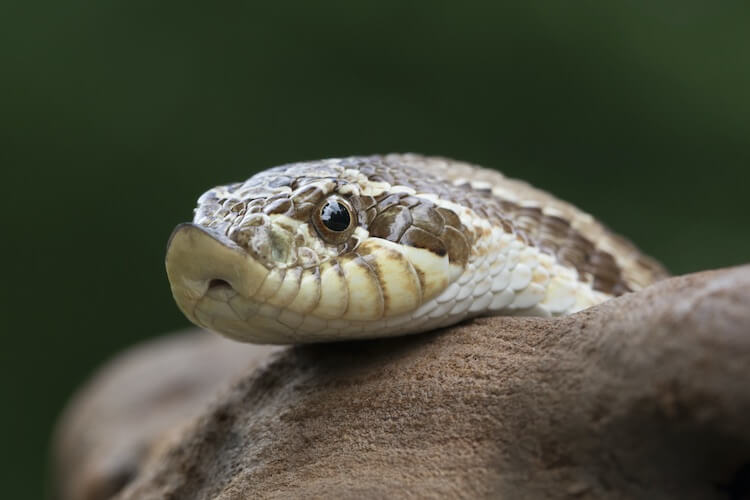
Western Hognose Snake
Western Hognoses are native to central North America.
These venomous snakes have a range all the way from southern Canada to northern Mexico. In these areas they are also known as:
- Prairie Hognose.
- Plains Hognose.
- Texas Hog.
- North American Puff Adder.
The Hognose gets its scientific name Heterdon nasicus from the Latin word “nasus” meaning “nose”.
They have a unique nose that scoops upwards to make burrowing easy. Their scoop nose and checkered body pattern make them one of the most beautiful snakes in North America.
Western hognoses are venomous and have rear fangs. This means they are capable of poisoning their prey with venom when hunting.
They are mildly venomous to humans, but are rarely aggressive. If they bite, they cause local swelling and skin rashes for more sensitive people.
Their venom is more dangerous to frogs, toads, lizards, and small rodents.
Western Hognose snakes are called “faux vipers” because they can: flatten their head, give warning strikes, shake their tail, puff up their body and play dead.
What We Like About The Western Hognose
Hognoses are known for their calm temperament and high tolerance for handling. They are great beginner snakes.
Pros
- Docile and calm temperament.
- Their adult husbandry is simple.
- They stay small and only grow to two feet in length.
Cons
- They like to hide in burrows and substrate.
- Juveniles may need frogs or lizards to start captive feeding.
- Sensitive people can experience swelling when bitten.
Species Appearance
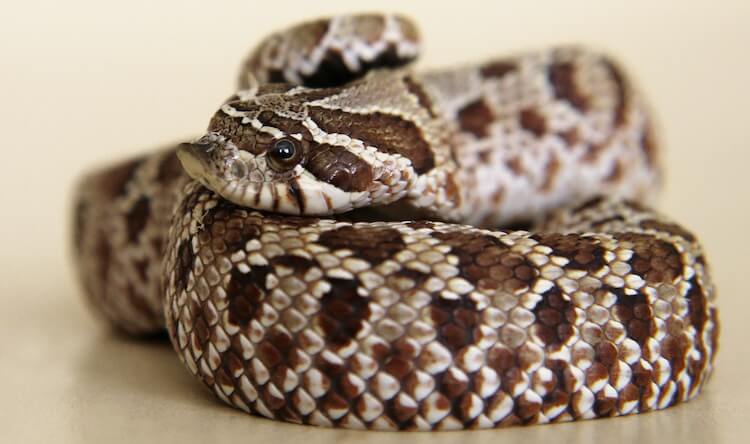
Perhaps the most unique part of the Western Hognose’s appearance is their nose. They have an upturned rostral bone that creates a scooped nose.
The Western Hognose Snake has a distinct checkered pattern and keeled scales.
Their keeled scales make them look like some species of western rattlesnake such as the Prairie, Western Diamondback and Mojave. Scientists believe their keeled scales are an evolutionary example of Batesian mimicry to protect them from predators.
Despite their ability to shake their tail, they do not have a rattle and are easily distinguished from rattlesnakes!
How Big Does A Western Hognose Snake Get?
An adult Hognose size is between 1.5 – 2 feet long. A female hognose snake’s length can reach three feet but two feet is average.
Western Hognoses hatch at 6 – 7 inches long regardless of their sex.
Western Hognose Snake Morphs
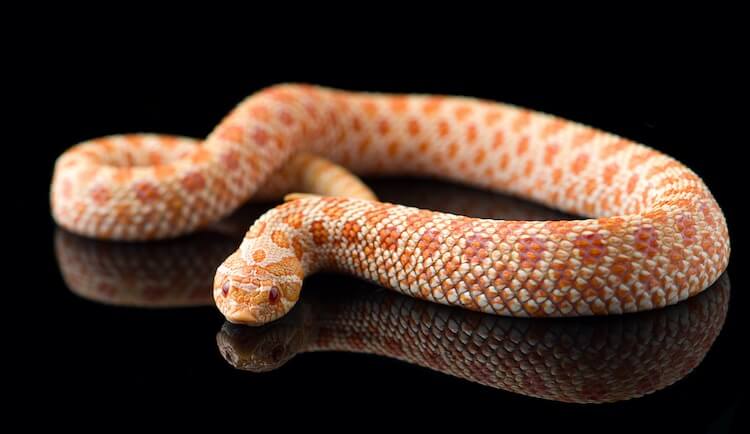
There are 45 recognized morphs of Western Hognose.
With their increasing popularity breeders have begun selectively breeding this species – just like ball python morphs.
Western Hognoses are normally tan-yellow or olive-gray.
There are slight color variations in the wild. Some can be more olive, gray, red or brown.
They also have dark brown or gray blotches that create saddles down their spine. They have two lines of smaller blotches along their sides that make a checker pattern.
Western Hognose Snake Care Sheet
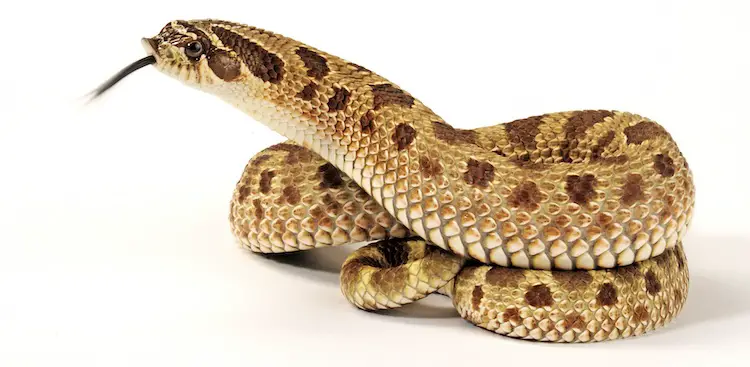
Caring for a Hognose is relatively simple.
An adult needs at least a 20-gallon terrarium with plenty of substrate for burrowing.
They prefer to eat amphibians (e.g. toads) in the wild but they can be fed frozen-thawed rodents if introduced at an early age.
Feeding Guide
Western Hognoses are carnivores that prey on a variety of animals in the wild. As juveniles they predominantly enjoy eating amphibians, but adults are opportunistic feeders and are known to eat:
- Toads.
- Small frogs.
- Lizards.
- Skinks.
- Eggs.
- Rodents.
In captivity providing adults with a varied diet can be difficult. It is best to only feed mice.
Mice should be a staple part of their diet:
- Hatchlings should be fed every five days.
- Juveniles between 6 – 18 months need to be fed every 7 – 10 days.
- Adults can be fed every 10 – 14 days.
Frozen-thawed mice are better than live mice. Live prey can sometimes bite or scratch your snake and cause an infection.
If your snake goes off mice then it can be helpful to feed frogs or lizards for a short period of time.
As your snake grows the size of the mouse you feed should too. A good rule of thumb is to feed mice that are the same diameter as your snake’s mid-region.
Your Hognose’s weight should be monitored closely to ensure young snakes are consistently gaining weight and adults are maintaining a healthy physique.
Finally, provide a water bowl large enough for your Hognose to soak in. This will help them hydrate properly.
Husbandry and Health Concerns
The Western Hognose Snake can live up 20 years if kept correctly.
Maintaining proper husbandry is essential for the health of your snake.
Poor husbandry can cause many illnesses:
- Respiratory Infections.
- Mouth and Scale Rot.
- Mites.
- Anorexia.
- Parasites.
For health issues such as mouth or scale rot and respiratory issues it is necessary to speak with a vet. Treatment often requires injectable antibiotics.
Fecal exams are the best diagnostic tool for internal parasites.
Mites affect the behavior of your snake. A snake with mites will soak more often to try to drown them. Also, mites may be tiny, but you can still notice them with the naked eye.
Signs They Are Healthy
- Growing at a consistent rate.
- Showing burrowing and hunting behaviors.
- Regularly shedding.
Sickness Symptoms
- Open mouth breathing.
- Biting or unusually defensive behaviors.
- Stuck shed on body or eye.
Hognose Snake Enclosure
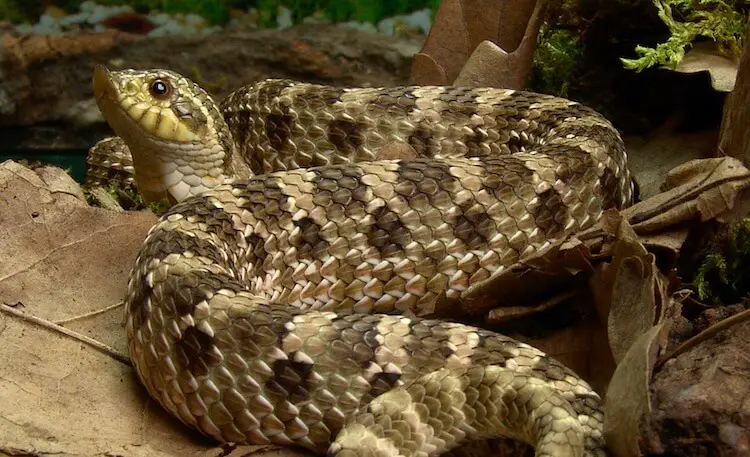
The Western Hognose lives in Central North America.
Their range is full of prairies, scrublands and floodplains. These habitats are ideal for Hognose snakes because they have low shrubs for hiding and sandy soils for burrowing.
The Hognose needs both of these environmental characteristics in captivity.
Hognoses are shy snakes that tend to burrow throughout the day to avoid heat and predators. They will only emerge at dawn and dust.
Cage & Set Up
Your enclosure should have many rocks, sticks and hides for your western hognose to hide under or shed against. He should also have a flat rock that serves as a basking area and 3″ deep substrate.
Hatchlings can live in a 10-gallon enclosure. After reaching one foot in length they should be transferred to a larger tank. Adults should live in a 20-gallon tank:
- Tank Type: plastic or glass.
- Tank Size: 20-gallon minimum*.
- Lighting: basking light required.
- Substrate: sand-soil mix .
* if you have a large or active western hognose you can increase the tank size to 50-gallons.
Western Hognose Snakes thrive with a humidity between 30% – 50%.
Their simple humidity requirements mean any type of enclosure material is okay – provided it is escape proof. Glass and vision-front enclosures are best, but plastic tubs can work with careful heat installation.
Hognose snakes need a daytime basking area that reaches 90°F – 95°F.
A basking bulb should be placed over a flat rock and should be on for 12 hours each day.
The tank’s ambient temperature should be between 80°F – 85°F and the cool side should never drop below 70°F. Monitor temperature levels at both sides of the tank with a digital thermometer and adjust as needed.
In a 20-gallon tank a basking spot placed at one end should be enough to create this temperature gradient.
At night heating is still necessary but it should drop by ~10°F.
Ambient temperatures should be 70°F on the cool side and 80°F – 85°F on the hot side.
You should use a thermostat-controlled ceramic heat emitter. It is best to avoid using under-the-tank heating mats because hognose snakes need a deep substrate. It can be hard to monitor belly heat correctly under several inches of substrate.
The best substrate for this species is a sand-soil mix. You should use an organic, fertilizer and perlite free topsoil and children’s play sand.
Make sure you put three inches of the sand-soil substrate in their enclosure.
Tank Cleaning
Sanitizing your snake’s cage regularly will help to lower risks from mold or pests.
You should spot clean your snake’s tank for feces daily.
It is also important to perform a deep clean and change the sand-soil substrate every three weeks.
Cleaning also gives you an opportunity to inspect your Western Hognose snake’s feces and general wellbeing.
Your snake should have consistent movements after eating. Their feces contain small amounts of a chalky white substance called urates and darker fecal matter. If this is too dry or white, your snake may have a digestion or hydration issue.
Typical Behavior
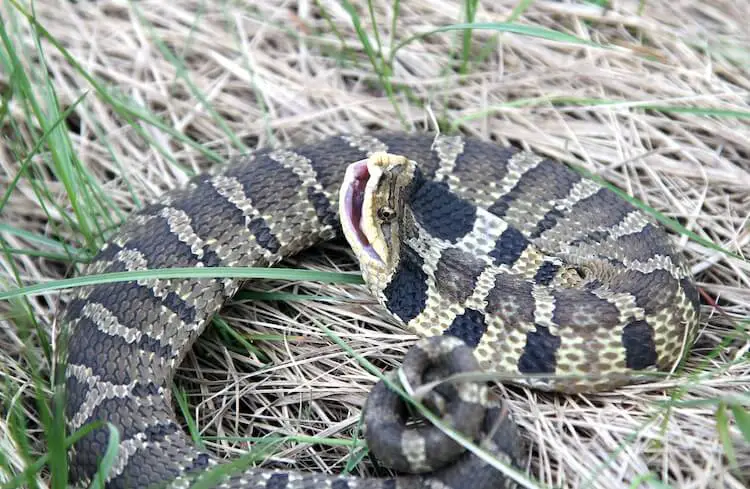
Western Hognoses have some of the most interesting and dynamic wild behaviors of any other North American species!
They are burrowing snakes so spend most of their time hiding or underground.
Hognose snakes are also crepuscular, so they only come out at dawn and dusk to root around in the soil for buried toads.
In captivity Hognoses typically continue their normal crepuscular, burrowing routine. They rarely bask but the option should always be provided as it helps their metabolism after eating.
These snakes are solitary and rarely are found together.
Cohabitating isn’t recommended.
Western hognose snakes are unlikely to cannibalize if they are similar in size and fed separately. However if there is a size difference or food scarcity they will sometimes fight.
Western Hognose Snake Playing Dead
When threatened western hognoses will show an array of defensive behaviors. They may puff up their body, produce a loud hiss, flatten their ribs to form a cobra hood and give closed-mouth false strikes.
If these behaviors don’t work the western hognose will roll over and stick its tongue out. They will writhe around and pretend to be dead.
Western Hognose Snake Bite
Western hognoses give “false strikes” by hitting the target with their head – instead of with their mouth.
The Western Hognose almost never bites so can be handled. It is important to move slowly and exercise caution when handling.
Hatchlings should be handled once every few days after they are given time to adjust to their enclosure. You can increase your handling frequency slowly.
Are Hognose Snakes Venomous?
The western hognose snake is mildly venomous to humans.
They have fangs that produce a mild venom in their saliva. It helps them hunt frogs, toads, lizards and small rodents.
Baby Western Hognose Snake
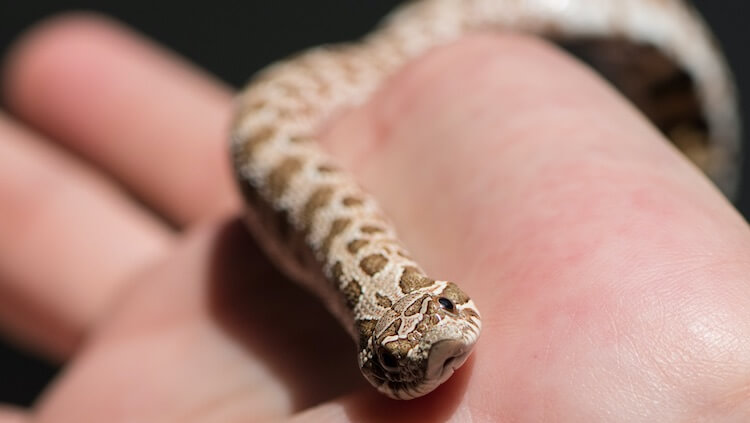
Western hognoses are oviparous.
This means baby western hognoses are laid in clutches of 12 to 15 eggs in a moist burrow. After 50 to 60 days the eggs hatch and produce a ~7 inch long hatchling.
Baby Western Hognose Snakes normally hatch with their adult coloration and pattern.
Some darken slightly with age, but for the most part, they retain their color from birth.
How Much Does A Western Hognose Snake Cost?
Hognose snakes are commonly bred for captivity throughout the United States.
Common Western Hognoses cost $175 – $250 from a private breeder. Adults are typically closer to $250 and hatchlings are sometimes sold for as low as $175.
Morphs such as the Lavender can cost $1,200.
In addition to making sure your snake is captive bred you should handle it before purchasing. This is a great way to gauge its health and activity level. A juvenile should respond by moving around your hand.
If the snake appears lethargic, overly stressed, or has signs of shed issues, then do not purchase.

Hognose Snake Facts
| Common Name | Texas Hognose, Prairie Hognose |
|---|---|
| Scientific Name | Heterodon nasicus |
| Price | $175 – $250 |
| Size | 1.5 – 2 feet long |
| Lifespan | 18 to 20 years |
| Diet | Mice, frogs, toads, lizards, and skinks |
| Tank Size | 20-gallon minimum |
| Humidity & Temperature | Daytime temperature: 80℉ – 85℉ Basking Spot: 90℉ – 95°F Humidity: 30% – 50% |
| Popular Alternatives | Kenyan Sand Boa, Garter Snake, Corn Snake |
Summary
The Western Hognose snake is small, docile and fun.
They have a great personality and their dynamic wild behaviors lead to many calling them the con-artists of the snake world!
If you are unsure about the venomous western hognose some great non-venomous alternatives are:
- Corn Snakes – slightly larger at 4 – 5 feet but have simple care requirements.
- Kenyan Sand Boas – also burrowers and smaller than western hognoses.
Hognoses are quickly becoming a popular beginner snake.
Their husbandry and general care are simple and straightforward. They are also calm, tolerate handling and have cute noses.
Do you think this snake could be your newest reptile? Let us know below!

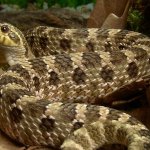
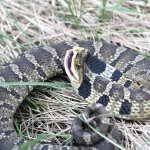
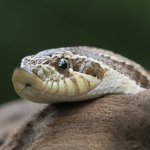
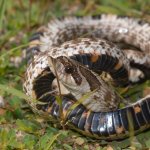
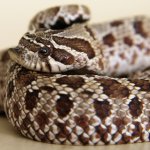
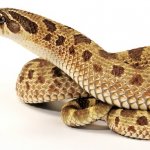
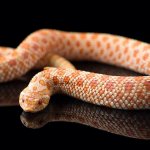
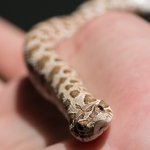
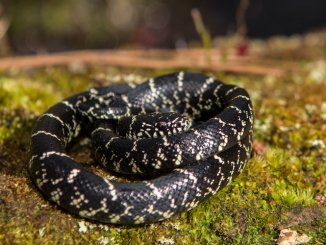
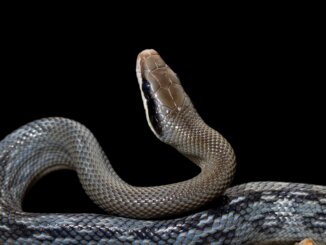
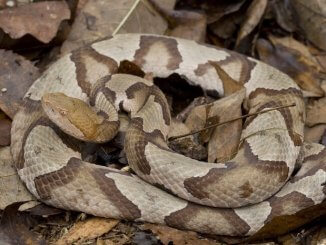
Great article, detailed and wonderful. Suitable for every breeder!
I had 2 of these little guys many years ago. I worked for a pet store and these snakes were a great educational tool for people that feared snakes. I knew about all of the characteristics you mentioned except one. They are venemous. Guess that was a good thing then. Lately I have been wanting another one or two but prices I am seeing are $400 and up. Your article was awesome, but also fueled the fire on wanting another. Oh, my previous hognoses were kept together and never had any issues.
I’ve been wanting a snake for years and my dads ask for it but my mother is not I’ve been researching about the best snake breed to get even though I’ve wanted a western hognose finding this website has helped me learn so much about these snakes and I think with the help of this website I can persuade my mom into letting me get one so thank you I’ve landed so much
Hi there Abbygail. This is literally what we are here for. Teaching people a little bit about reptiles among other animals. With snakes, this is particularly important, because they are commonly despised for no good reason. In my experience, most people who do not want anything to do with snakes are among the fastest to change their mind when they actually meet one. Hope your mom is one of these 🙂